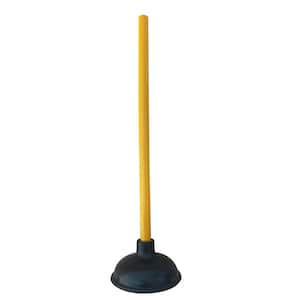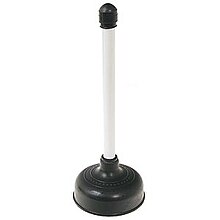Ways to Properly Apply Plunger and Drain Cleaners: Professional Tips
Ways to Properly Apply Plunger and Drain Cleaners: Professional Tips
Blog Article
What're your opinions about Tips on How to Effectively Use a Plunger?

Intro
Correct upkeep of family drains pipes is necessary for stopping clogs and making certain smooth water flow. Among the secret tools in every home owner's toolkit is the bettor, together with various drainpipe cleaners created to tackle stubborn clogs successfully. This article checks out how to utilize bettors and drainpipe cleansers efficiently to maintain your drains pipes flowing easily.
Area 1: Understanding Plungers
Sorts of Plungers
There are several kinds of plungers offered, each created for various kinds of drains pipes and clogs. One of the most usual kinds consist of mug bettors, flange bettors, and accordion plungers.
Just How Plungers Work
Bettors deal with the concept of producing pressure and suction to remove obstructions. When correctly used over a drainpipe, they create a vacuum that can take out debris or separate clogs.
Selecting the Right Plunger
Selecting the right bettor relies on the kind of drainpipe and the nature of the clog. Cup bettors are suitable for sinks and tubs, while flange plungers are much better suited for commodes because of their design.
Typical Mistakes with Bettors
Preventing these mistakes makes certain effective plunging: inappropriate seal around the drain, inadequate pressure, and not clearing surrounding debris.
Area 2: Making Use Of Plungers Efficiently
Preparation
Prior to diving, guarantee the plunger covers the drainpipe entirely and creates a limited seal. Clear any noticeable particles around the drainpipe opening.
Strategy
Beginning with mild diving motions to construct suction. Increase pressure gradually, using a consistent rhythm. Repeat as required until the drainpipe removes.
Fixing Tips
If plunging does not function, attempt changing the seal, using oil jelly for a better seal, or making use of a different kind of plunger.
Section 3: Understanding Drainpipe Cleaning Company
Kinds Of Drain Cleaners
Drain pipes cleansers can be chemical or enzymatic. Chemical cleaners use strong chemicals to liquify clogs, while chemical cleaners make use of all-natural enzymes to break down organic matter.
Exactly How Drainpipe Cleaning Company Work
Chemical cleansers react with obstructions to dissolve them, while chemical cleansers break down natural products like hair and grease without damaging pipelines.
Security Factors to consider
Always use handwear covers and eye defense when using chemical drain cleansers. Make sure adequate ventilation and comply with maker guidelines carefully.
Eco-Friendly Alternatives
Think about making use of vinegar and cooking soft drink or enzyme-based cleansers for environmentally friendly choices that are much safer for pipelines and the setting.
Area 4: Utilizing Drain Cleaners Properly
Application Strategies
Put chemical cleaners straight right into the drain opening. Allow them to help the advised time prior to purging with warm water. Enzymatic cleansers need to rest overnight.
Safety measures
Avoid blending various types of cleaners, as this can produce toxic fumes. Never ever use chemical cleaners along with a bettor, as splashing can happen.
Dealing With Stubborn Blockages
For relentless obstructions, consider making use of a plumbing serpent or calling a professional plumber to prevent damage to pipelines.
Verdict
Finally, comprehending exactly how to make use of plungers and drainpipe cleaners properly is necessary for keeping healthy pipes systems. By choosing the right tools and strategies, homeowners can take on small obstructions and protect against significant pipes problems down the line.
5 Steps on How to Use a Plunger Effectively
Creating a Seal: Place the rubber cup of the plunger firmly over the toilet drain hole to create an airtight seal. This seal is crucial to prevent air from escaping and ensure effective plunging.
Plunge Gently: Gently press the plunger down to compress the air inside without causing splashing. This careful action sets the stage for effective unclogging without creating a mess.
Maintaining Pressure: Consistently apply pressure to the plunger while pushing and pulling it up and down. This sustained pressure generates the force needed to dislodge the clog.
Breaking the Clog: Continue plunging until you feel the clog release. Look for the water to start draining, indicating successful removal of the blockage.
Flushing and Cleaning: After clearing the clog, flush the toilet to confirm it's working properly. Clean the plunger with warm, soapy water and disinfect it for future use to maintain hygiene.
Additional Tips on How to Correctly Use a Plunger
if you encounter resistance, add some water to the bowl to create better suction;
check the plunger for any rubber cracks to ensure it's in good condition;
exercise patience and persistence, as certain clogs might need multiple attempts.
Mistakes to Avoid when Using Toilet Plunger
avoid using excessive force, as it may damage the toilet;
don't rush the process; take your time to ensure a proper seal and pressure;
never use a plunger if you've recently used chemical drain cleaners
Conclusion
Mastering the art of how to properly use a plunger is a valuable skill for every homeowner. By employing the correct techniques, you can effectively address clogs and ensure your toilet functions smoothly. Patience, persistence, and proactive in maintaining your plunger's hygiene are key to success in this endeavor.
Armed with these skills and principles, you can confidently handle plumbing issues as they arise, promoting a well-functioning and hygienic home environment.
https://homealliance.com/blogs/how-to-effectively-use-a-plunger-the-ultimate-guide

Application Strategies
Put chemical cleaners straight right into the drain opening. Allow them to help the advised time prior to purging with warm water. Enzymatic cleansers need to rest overnight.
Safety measures
Avoid blending various types of cleaners, as this can produce toxic fumes. Never ever use chemical cleaners along with a bettor, as splashing can happen.
Dealing With Stubborn Blockages
For relentless obstructions, consider making use of a plumbing serpent or calling a professional plumber to prevent damage to pipelines.
Verdict
Finally, comprehending exactly how to make use of plungers and drainpipe cleaners properly is necessary for keeping healthy pipes systems. By choosing the right tools and strategies, homeowners can take on small obstructions and protect against significant pipes problems down the line.
5 Steps on How to Use a Plunger Effectively
Creating a Seal: Place the rubber cup of the plunger firmly over the toilet drain hole to create an airtight seal. This seal is crucial to prevent air from escaping and ensure effective plunging. Plunge Gently: Gently press the plunger down to compress the air inside without causing splashing. This careful action sets the stage for effective unclogging without creating a mess. Maintaining Pressure: Consistently apply pressure to the plunger while pushing and pulling it up and down. This sustained pressure generates the force needed to dislodge the clog. Breaking the Clog: Continue plunging until you feel the clog release. Look for the water to start draining, indicating successful removal of the blockage. Flushing and Cleaning: After clearing the clog, flush the toilet to confirm it's working properly. Clean the plunger with warm, soapy water and disinfect it for future use to maintain hygiene. Additional Tips on How to Correctly Use a Plunger
if you encounter resistance, add some water to the bowl to create better suction; check the plunger for any rubber cracks to ensure it's in good condition; exercise patience and persistence, as certain clogs might need multiple attempts. Mistakes to Avoid when Using Toilet Plunger
avoid using excessive force, as it may damage the toilet; don't rush the process; take your time to ensure a proper seal and pressure; never use a plunger if you've recently used chemical drain cleaners Conclusion
Mastering the art of how to properly use a plunger is a valuable skill for every homeowner. By employing the correct techniques, you can effectively address clogs and ensure your toilet functions smoothly. Patience, persistence, and proactive in maintaining your plunger's hygiene are key to success in this endeavor.
Armed with these skills and principles, you can confidently handle plumbing issues as they arise, promoting a well-functioning and hygienic home environment.
https://homealliance.com/blogs/how-to-effectively-use-a-plunger-the-ultimate-guide

I'm very fascinated by How to Unclog Your Sink with a Plunger and I am hoping you appreciated my post. If you please take the opportunity to share this post if you appreciated it. I truly appreciate reading our article about A Guide to Plungers (and How to Use Them).
Go Deal Now Report this page